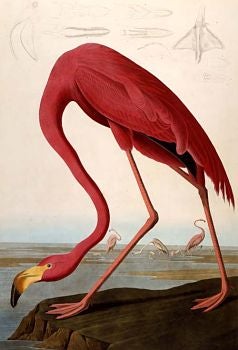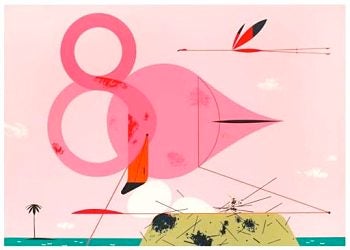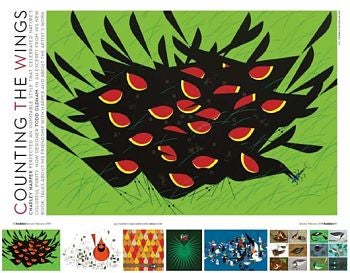 |

Left: John James Audubon's greater flamingo. Above: A flamingo by illustrator Charley Harper. |
People will pay a pretty penny for a John James Audubon original--case in point: At Sotheby’s auction last night, Londoner Michael Tollemacher laid down a cool $11.5 million (U.S.) for Audubon’s
Birds of America, the most expensive published book ever sold (for more on that story, click
here). The giant folio isn't just a historic scientific guide to birds; it's an artist's masterpiece as well. Such news brings to mind several other avian oeuvres that have graced the pages of
Audubon. In studying the images, you might discover a bit of J.J.A’s influence—not necessarily in their similarity to his work, but in their contrasts.

Take artist Charley Harper, for example. While Harper illustrated everything from molecules for
The Giant Golden Book of Biology, a 1961 classic, to fruit slices for Libby’s Pineapple Chunks advertisements, he also carved out a niche for himself among the great artists of avifauna. “He’s a rock star in the bird world,” designer
Todd Oldham told me in an interview for a
2008 article in Audubon (see images above). Although Harper described his technique as “minimal realism,” the term underplays what was involved in his work. The clean lines and flat planes of contained color that he employed were the product of months spent studying, composing, and mixing pigment for his pieces in a studio that— ironically—was “a complete and utter tornadoed mess,” according to Oldham.
Harper looked to field guides to help him accurately portray the birds he chose to illustrate, never altering their colors or fabricating new species. “Charley had a whole library of bird books,” Oldham told me. “He was very earnest and honest in the representation.” Still, a depiction of a
cardinal with a tear-shaped body or an
owl with moon-sized eyes might seem more like a cartoon than a mirror image. But by distilling a bird to a collection of seemingly simple shapes and colors, Harper successfully captures its purest essence.
“Charley’s inspired, yet accurate, color sense is undeniable and, when combined with the precision he exacts on rendering only the most important details, one is always left with a sense of awe,” Oldham writes in
Charley Harper: An Illustrated Life, an encyclopedic monograph of Harper illustrations (AMMO Books, $200), “As Charley says, ‘I just count the wings, not the feathers.’ ”
In stark opposition to Harper, photographer
Andrew Zuckerman’s most recent book, aptly named
BIRD, is an aviary album rich in species variety, and one that pays strict attention to minute detail. Massimo Vignelli writes in the introduction:
In John James Audubon’s fabulous drawings of birds, he depicts every detail with great care, feather by feather, with a distinct color for each layer of feathers and great precision with the color and expression in their eyes. He places the birds in their own habitats with equally meticulous consideration. The narrative intention of the drawings is clearly stated; there are no doubts about the author’s goal. He chooses to show the bird in its own environment, and for him, the story is complete…
And he continues...
Andrew Zuckerman approaches birds with a contemporary, minimalist attitude: no more narrative context, no more psychological interpretations, no more candid shots in the wilderness. An absolute background made of pure white light acts as the field on which the birds fly or rest. In this incredibly luminous setting, the colors of the birds’ plumage come to life as never before seen by the human eye.
Are there other bird artists, illustrators, or photographers who have caught your eye? Let us know in the comments section.



